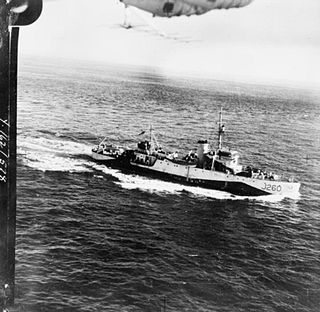Battle honours
- Atlantic 1941–45
- Gulf of St. Lawrence 1944
Several Canadian naval units have been named HMCS Ungava.

Several Canadian naval units have been named HMCS Vancouver. One was named for the explorer George Vancouver, the others after the city of Vancouver.
Several Canadian naval units have been named HMCS Nootka.
USS MacKenzie may refer to:
Several Canadian naval units have been named HMCS Charlottetown after the provincial capital of Prince Edward Island. Uniquely in Canadian naval history, two of these vessels had the same name and pennant number.
Cowichan may refer either to:
Three Canadian naval units have carried the name HMCS Chignecto.
Three Canadian naval units have carried the name HMCS Miramichi.
HMCS Ungava was a Bangor-class minesweeper that served in the Royal Canadian Navy during the Second World War. She saw action in the Battle of the Atlantic and the Battle of the St. Lawrence. Following the war she was scrapped. She was named for Ungava Bay.
USS Sanderling is a name the United States Navy has used more than once in naming its vessels:
A motor minesweeper is a small minesweeper, powered by an internal combustion engine, very often of wooden construction, designed to locate and destroy mines in coastal waters and harbors. Many navies have used such ships.
HMCS Miramichi was a Bangor-class minesweeper that served in the Royal Canadian Navy during the Second World War. She remained on the west coast of Canada for the entirety of the war. She was named for Miramichi, New Brunswick. After the war she was purchased with the intent of conversion for mercantile use. However, that never took place and instead, she was scrapped in 1949.
Several Canadian naval units have been named HMCS Nipigon.
Several Canadian naval units have been named HMCS Cowichan;
Several Canadian naval units have been named HMCS Levis after Lévis, Quebec.
Several Canadian naval units have been named HMCS Thunder;
HMCS Courtenay was a Bangor-class minesweeper constructed for the Royal Canadian Navy during the Second World War. Entering service in 1942, Courtenay spent the entire war on the West Coast of Canada. The vessel was decommissioned in 1945 and sold for mercantile service in 1946. The fate of the vessel is uncertain.

HMCS Goderich was a Bangor-class minesweeper constructed for the Royal Canadian Navy during the Second World War. Entering service in 1941, Goderich spent the entire war as a local convoy escort based out of Halifax, Nova Scotia. The vessel was decommissioned in 1945 and placed in reserve. Reacquired during the Korean War, the vessel was modernized but never re-entered service and was sold for scrap and broken up in 1959.
HMCS Quinte was a Bangor-class minesweeper constructed for the Royal Canadian Navy during the Second World War. The ship entered service in 1941 and took part in the Battle of the Atlantic. On 30 November 1942, Quinte ran aground and sank off Cape Breton Island. The ship was re-floated and repaired and spent the rest of the war as a training ship. Following the war, the minesweeper was used for naval research until decommissioned in 1946. The vessel was sold for scrap and broken up in 1947.
Several Canadian naval units have been named HMCS Quinte;
HMCS Ungava was a Bay-class minesweeper that was constructed for the Royal Canadian Navy during the Cold War. Entering service in 1954, the minesweeper was paid off in 1958 and transferred to the Turkish Navy. Renamed Tekirdağ, the ship remained in service until 1991 and was broken up in 2002.